Abstract
Semicircular canal plays an important role in sensing of human body orientation. Cupula is the system in semicircular canal responsible for sensing rotational head movements. It is excited by the flow of endolymph caused due to inertia of head movement. There are various disorders related to semicircular canal, the most common disorder is Benign Paroxysmal Positional Vertigo (BPPV). Present work focuses on determination of response of cupula due to endolymph flow in the horizontal semicircular canal. Variation of pressure generated on cupula by endolymph for different rotational velocity of head is studied and reported. Response of cupula with appropriate boundary conditions is extracted. Results obtained open up new area of research in better understanding the behavior of cupula with endolymph flow. It may aid in the betterment of curing BPPV.
1. Introduction
Balancing of human body plays major role in daily human activities. It is managed by vestibular system. Vestibular system consists of otolith organs and semicircular canals. Otolith organs senses linear acceleration. Semicircular canals senses rotational acceleration around three mutually perpendicular axes. Endolymph is a fluid that is flowing in semicircular canal, plays a major role in sensing of angular head rotation. Cupula is a hydro gelatinous mechanical sensor situated in semicircular canal. It is excited by the flow of endolymph. Mechanical deformation of cupula is converted into electrical signals by hair cells which is sent to brain for further reflexes. Disrupting the flow causes improper deflection of cupula leading to false sense and improper reflexes. Benign Paroxysmal Positional Vertigo (BPPV) is a vestibular system disorder. It occurs when calcium carbonate crystals called otoconia present in otolith organs enter the semicircular canal. Presence of otoconia in semicircular canal disturbs the flow of endolymph (canalithiasis) or may settle on cupula resulting in improper deflection (cupulolithiasis). There are various treatments for BPPV, head maneuver is one common treatment used. Head maneuver is not an effective way to treat BPPV because curing time and reoccurrence rate is high. There is an urge to advance these curing methods or new methods should be proposed. Analysing and predicting the response of cupula due to endolymph flow helps in inception of such treatments.
Curthoys et al., [1] performed autopsy on infants with fully developed labyrinth to extract horizontal semicircular canal. Analyzed the canal under a microscope and established a cross-sectional model of the canal. Akhilesh et al., [2] modelled horizontal semicircular canal and cupula, extracted the natural frequency and mode shapes of cupula with and without otoconia. Marcus and Wingemann [3] tabulated the chemical composition of endolymph. Carey and Santina [4] presented the principles of vestibular system and disorders of vestibular system. Reported the spatial orientation of semicircular canal. Johan Bergenius and Tatjana Tomanovic [5] described the disorder of vestibular system and nystagmus characteristics. Reported distance between centre of semicircular canal and central axis of head (centre of foramen magnum). Selva et al., [6] reported the value of Young’s modulus and Poisson ratio for cupula. Shen et al. [7] conducted simulation of three semicircular canal with appropriate material properties of endolymph and cupula.
Present paper, a 3D model of semicircular canal and cupula is considered. Simulation of endolymph flow of horizontal semicircular canal is carried out. CFX analysis provides the pressure generated on cupula. Response of cupula is obtained for various rotational velocities of head. Variation of pressure generated on cupula and response of cupula is studied and reported.
2. Modelling of horizontal semicircular canal
Model of horizontal semicircular canal and cupula is considered [2]. Spatial orientation of semicircular canal in humans is as shown in Fig. 1. Semicircular canal is oriented at 20° with the horizontal plane as shown in Fig. 2 [4]. Distance between the centre of semicircular canal and central vertical axis of 42 mm as shown in Fig. 3 [5].
Fig. 1Spatial location and orientation of H-SCC
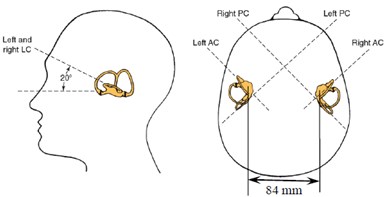
Fig. 2Angle of H-SCC with to horizontal plane
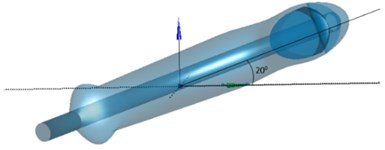
Fig. 3Location of semicircular canal taking global axis as foramen magnum
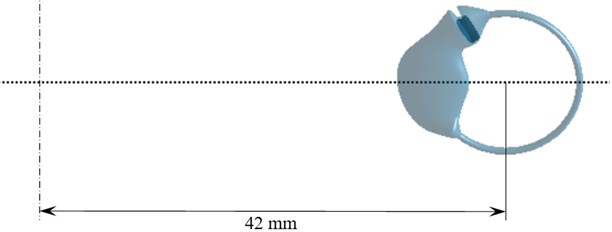
Global axis is considered as foreman magnum. It is the vertical head axis, around which head rotates and so does the semicircular canal.
3. Flow simulation of endolymph
Semicircular canal is filled with endolymph. Any disturbance in the flow of endolymph affects the deflection of cupula leading to false sense of body orientation (BPPV).
The chemical composition of endolymph is listed in Table 1. Atomic mass of the elements is used to calculate molar mass. The molar mass of endolymph is calculated to be 6043.77 g/mol as shown in the calculation
A fine tetrahedral mesh is generated over entire horizontal semicircular canal without cupula. It consists of 2,55,618 nodes and 12,23,885 elements. The normal view of meshed horizontal semicircular canal is as shown in Fig. 4.
Fig. 4Meshed horizontal semicircular canal
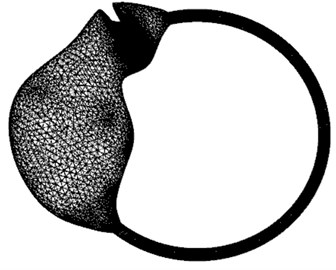
The meshed model is imported to CFX-Pre Ansys18.1. A new fluid material is created in library namely endolymph. Appropriate fluid properties are used is listed in Table 2. It is applied for the CFX domain. CFX-post provides the results of the analysis. Parameters like pressure generated on cupula, pressure generated on HSCC and streamline velocity of endolymph is extracted from the CFX analysis.
Table 1Fluid composition of endolymph [3]
Na+ (mM) | 9 |
K+ (mM) | 149 |
Ca+ (mM) | 0.28 |
pH | 7.5 |
Table 2Material property of endolymph [7]
Parameter | Value |
Viscosity | 0.000852 Pas |
Molar mass | 6043.77 g/mole |
Specific heat | 4186 J/K/kg |
Density | 1000 kg/m3 |
Streamline flow of endolymph is as shown in Fig. 5, pressure generated on horizontal semicircular canal is as shown in Fig. 6.
Fig. 5Streamline flow of endolymph at 0.873 rad/s rotational velocity of head
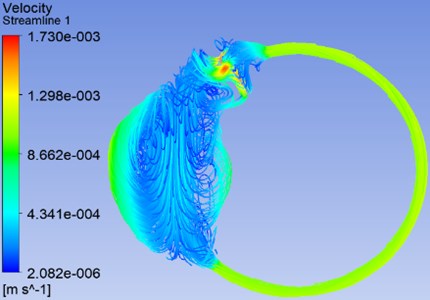
Pressure generated on cupula is as shown in Fig. 7 for 0.873 rad/s angular velocity of head is presented. The pressure and velocity are calculated by the CFX solver using Navier-Stokes equation and conservation of mass equation.
Similar analysis is carried out for other rotational velocities of head, extracting the same parameters. The variation of pressure generated on cupula for various rotational velocities of head is as shown in Fig. 8.
Fig. 6Pressure generated on canal at 0.873 rad/s of rotational velocity of head
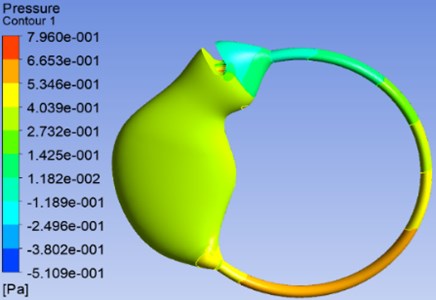
Fig. 7Pressure generated on cupula for 0.873 rad/s rotational velocity of head
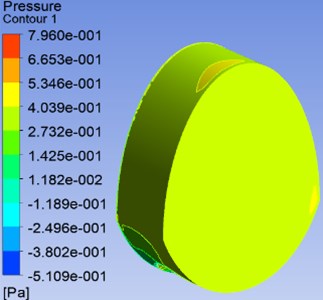
The pressure generated on cupula increases with increase in rotational velocity of head. The generated pressure on cupula is imported to perform harmonic analysis to determine the response of cupula.
Fig. 8Variation of pressure generated on cupula v/s rotational velocity of head
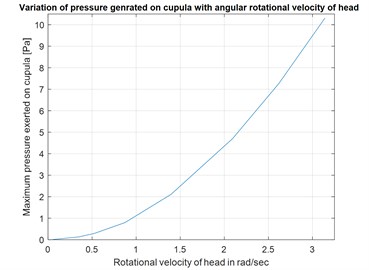
Fig. 9Variation of response of cupula v/s head rotational velocity
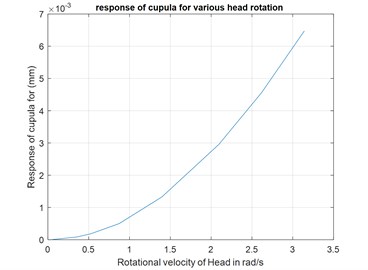
The base of cupula is considered as fixed support, considering the cupula to have wiper arc motion. The material properties of cupula and mesh model are borrowed from [2]. The response of cupula is extracted for rotational velocity of head from 0 rad/s to rad/s.
The variation in the response of cupula with the rotational velocity of head is as shown in Fig. 9. The response of cupula increases with increase in pressure generated on cupula caused due to increase in rotational velocity of head.
4. Conclusions
In the present work, a 3D model of horizontal semicircular canal and cupula is considered. Appropriate orientation of horizontal semicircular canal is used to achieve accurate results. CFX analysis of horizontal semicircular canal is carried out for rotational head velocity from 0 rad/s to rad/s. Pressure generated by endolymph on horizontal semicircular canal and cupula and velocity of endolymph is extracted and reported. It is noted that there is an increase in the pressure generated on cupula with increase in rotational velocity of head. Harmonic analysis is carried out by importing the generated pressure. Response of cupula is determined and reported. The response of cupula is found to increase with increase in rotational velocity of head. As a part of future scope, simulation of endolymph with otoconia flowing in semicircular canal and it can be extended to three semicircular canals.
References
-
Curthoys Ian S., Oman Charles M. Dimensions of the horizontal semicircular duct, ampulla and utricle in the human. Acta Otolaryngologica, Vol. 103, 1987, p. 254-261.
-
Akhilesh Hari Prakash, Anudeep Joshi, Darshan Babu, Chandrashekara C. V. Simulation model of human cupula for free vibration analysis. Vibroengineering Procedia, Vol. 30, 2020, p. 121-125.
-
Marcus Daniel C., Wangemann Philine Cochlear and Vestibular Function and Dysfunction. Physiology and Pathology of Chloride Transporters and Channels in the Nervous System, 2009, p. 425-437.
-
Carey John P., Santina Charles C. Della Principles of Applied Vestibular Physiology. Otolaryngology: Head and Neck Surger. 4th ed., Elsevier Mosby, Philadelphia, Vol. 3, 2005, p. 3115-3159.
-
Bergenius Johan, Tomanovic Tatjana Persistent geotropic nystagmus – a different kind of cupular pathology and its localizing signs. Acta Oto-Laryngologica, Vol. 126, Issue 7, 2006, p. 698-704.
-
Pierre Selva, Oman Charles M., Stone Howard A. Mechanical properties and motion of the cupula of the human semi-circular canal. Journal of Vestibular Research, Vol. 19, 2009, p. 95-110.
-
Shen Shuang, Liu Yingxi, Sun Xiuzhen, Zhao Wei, Su Yingfeng, Yu Shen, Liu Wenlong A biomechanical model of the inner ear: numerical simulation of the caloric test. The Scientific World Journal, Vol. 2013, 2013, p. 160205.
